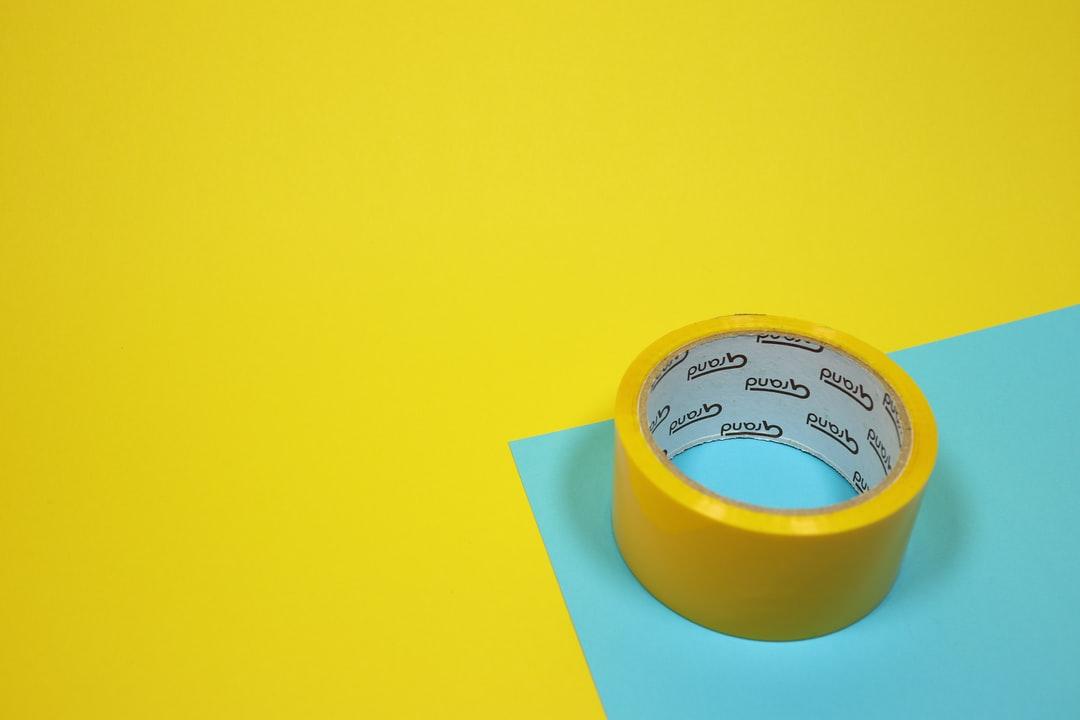The Complete Guide to Tape Adhesives
When it comes to adhesive tape, knowing the different types of adhesives is an essential step in choosing the right tape for you. Not all adhesives are created equal. Some tape adhesives are easy release, some have extra-strong grip, and some are designed to withstand outdoor usage. All are useful in their proper context, but you need to have the right tape for the right job. You wouldn't, for instance, want to use a painter's tape with a weak adhesive on a heavy-duty industrial project.
The main issue with buying tape online is that there are literally dozens of different types of adhesive tape on the market. Within each of these types, you can select from different options such as color, width, and thickness. The high degree of variation allows clients to select tapes that are perfectly tailored to their needs. However, some consumers can feel overwhelmed when reviewing their choices. Additionally, when you buy tape online, you have no way of knowing exactly how well the tape will work until your order arrives. Imagine buying a custom packing tape only to discover when it arrives that the width isn't compatible with your box sizes!
To avoid these problems, let’s look at the most important factors for choosing the best adhesive tape for your needs. This tape guide is not a fully-encompassing class on all of the myriad tape options and styles, but it will instruct you on the basics of tape adhesives so that you can make an informed decision. Before describing specific types of adhesives, let's define some essential tape terminology.
Thickness
Tape thickness is usually measured in the United States in “mils”, or thousandths of an inch (1/1000”). The thickness can be measured from the bottom of the adhesive surface to the top of the outer surface or simply the film itself. In most cases, the thicker the tape the stronger and more durable it is. This is referred to as tensile strength. Thinner tape tends to be used for lightweight or temporary applications whereas thicker material is required for sealing heavy boxes and other heavy-duty applications. Duct tape is a great example of a thick adhesive roll whereas painting tape is often very thin and hand tearable.
Width
Width is the measure of the tape from one side of the roll to the other. Wide rolls make excellent packing tape because they cover more surface area. They are usually sturdier than narrow tape rolls. If you need tape for packaging or covering something up, choose the tape that provides the most surface contact with the material that you are taping up. This is especially important because post offices will note if your adhesive is insufficient. Moreover, if your packaging falls apart during transit, the shipping service may be unable to ship it.
Surface Features
Surface features are the different types of surfaces on the non-adhesive side or the tape. Tape surface features include non-slip grip, easy to write on surfaces, and reinforced layers for extra strength. To decide what surface features you want, you need to consider how you intend to use the tape. Non-slip grip is great for boxes that will be handled frequently, while easy to write on, non-smudge surfaces are ideal for labeling.
Color Options
In most cases, you can choose different colors for your tapes. Depending on the purpose of the tape and the industry you work in, you may need to choose pre-determined colors for specific purposes. Classic examples include red for restricted areas, blue for medical purposes, and yellow and black caution tape for dangerous areas. Tape color coding varies according to individual needs, but there are some global standards. Luckily, Tape Jungle stocks standardized DOT tape and similar color-coded tapes.
You may also choose a tape color based on branding or personal preferences. If your company uses certain colors in its advertising, using those same colors for your custom branded tape will improve your brand recognition. If you print tape with a stylized logo, you should select a background color that will contrast well with the logo design. And of course, you are free to choose a tape color purely because you like how it looks.

Types of Adhesives
Adhesives are a sadly overlooked aspect of tape selection. When you're purchasing tape for your business, it's easy to think about things like the material and the number of rolls. But too often, people don't consider the importance of the tape's adhesion. Different varieties of tape use different types of adhesive with different properties. If you don't factor in the adhesive type when you choose your tape, you might end up with an adhesive that's too weak or too strong for your projects. Too weak, and the tape will come loose. Too strong, and the tape might rip off paint or damage cardboard.
Before ordering any type of tape, check to see what kind of adhesion it uses. The adhesive side of a tape roll, colloquially called the "sticky side", commonly comes in three varieties: acrylic, hot melt, and natural rubber.
Hot Melt
Hot melt adhesive is the default adhesive for many tapes. It is used in polypropylene (PolyPro) tapes. It is made of thermoplastic polymers and as a result, it has good adhesion, excellent holding power, and a high tensile strength. Hot melt adhesive tapes have three layers: the non-adhesive surface layer, the release layer, and the adhesive layer. Holt melt adhesives tend to be more durable than acrylic adhesives. They can withstand large temperature fluctuations without warping or becoming brittle.
Hot melt adhesives are good for general-purpose use. If you want a tape that works well for labeling, packaging, and miscellaneous usage, a hot melt adhesive tape is a good choice. However, if you want specialized tapes for specific projects, you should consider a tape with an acrylic, natural rubber adhesive or a water-activated adhesive.
Acrylic Adhesive (water based and solvent)
Acrylic tapes are known for strong bonding and tolerance of high temperatures. There are two types of acrylic tapes, water-based acrylic and solvent acrylic. Water-based acrylics are less expensive and usually found in your economical Tapes. Most inexpensive imported tapes from China and Indonesia are water-based Acrylics. Solvent based acrylics cost more but are much more aggressive and work well with a lot of the recycled corrugated paper boxes being produced today.
Natural Rubber
Solvent based natural rubber adhesives are used in carton sealing PVC tapes, and Polypropylene tapes. Natural rubber adhesives bond well to a variety of materials including leather, fabrics, and paper. Polypropylene natural rubber adhesive tapes are also known as cold room tapes. They can withstand temperatures 0-150 degrees F. These tapes have good water resistance and have been specifically made to adhere to recycled corrugated. They have a quiet unwind and make excellent packaging tape. Because rubber is non-conductive, electrical tapes often use a natural rubber adhesive.
Natural rubber is a great option if you run a small business with a limited budget, PVC tapes with rubber adhesives are a good cost-effective choice. It is more durable than standard PolyPro tape, which makes it suitable for more heavy-duty packing. If you plan to ship heavy packages, you should stock some tapes with rubber adhesives so that you can guarantee the security of your packages.
Water-Activated
If you've ever spilled a glass of water on a roll of Scotch tape, you know that many tapes lose their stickiness when they get wet. Water-activated tape, however, is unique because its adhesive is only activated by water. When the adhesive on water-activated tape is moistened, it bonds to whatever surface it is applied to. If you apply water-activated tape to a box and the box later winds up stuck in the rain, you can rest assured that the adhesive will remain intact.
Water and Solvent Based Acrylics
Water-activated adhesives are very popular for packing tape. When the adhesive is used on cardboard, the bond it creates is so strong that the tape cannot be removed without damaging the cardboard. As a result, it is the perfect tamper-evident packaging. No one can open a box sealed with water-activated tape without leaving obvious evidence. Water-based is the cheapest of all adhesives.
Due to its unique adhesive, water-activated tape cannot be applied by hand. It needs to be applied with a specialized dispenser. Luckily, good tape dispensers are durable, reusable, and easy to find online. Plus, applying tape with a dispenser results in neater, more professional-looking packaging compared to tape that has been applied manually. The dispenser will require minimal cleaning and adjustment. In return, it will provide your business with an efficient way to safely package your products.
Browse Endless Options At Tape Jungle
Tape Jungle eliminates many of the problems with the tape industry by providing detailed customization options and educating clients so that they can make informed decisions. Tape Jungle provides custom printed tape, including digital printed tape. Clients can review their selections and see a digital mock-up of their tape design before placing their orders. The Tape Jungle blog has an extensive archive containing everything you need to know about every type of tape on offer.
We thank you for choosing Tape Jungle. We appreciate the opportunity to serve you. These are just a few of the factors that you need to know about and keep in mind when you are looking for tape for your needs. We can’t wait to help you find the perfect adhesive tape products for your needs and to help you place your order and arrange delivery.
At Tape Jungle, our experts can provide even more information. If you are still in need of guidance, or if you have any questions about any of our specific products, please reach out by using our contact form. We look forward to helping you get the best tape products that you need at a great price, delivered fast right to your door.


 Canadian Dollar
Canadian Dollar
